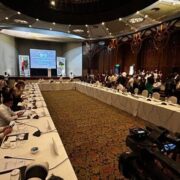State of climate change 2025

The Philippine Disaster Resilience Foundation recently conducted its 2nd annual State of Climate Change Forum. The state of our environment and its effects on climate change is one of the most important topics we need to address as a nation. In last year’s inaugural State of Climate Change Forum, DENR Secretary Toni Yulo-Loyzaga spoke about Engineering Partnerships for Climate Resilience. This is a theme we will continue to push this year.
Last year, the Secretary spoke about the hazards and risks we face and our response to those hazards. She spoke about strategic mitigation and building capacity for adaptation as she identified the 18 provinces with the highest exposure to hazards.
She spoke about our climate action in terms of clean air, waste management, clean water, renewable energy, biodiversity, minerals development, and, of course, our oceans.
Since last year, what has been happening since then? While the Paris Agreement is committed to ensuring that the global temperature does not exceed 1.5 degrees Celsius versus preindustrial levels, last year was the hottest on record. Both the European Union’s Copernicus Climate Change Service and the United Nations’ World Meteorological Organization compiled several climate trackers and determined that the world’s global surface temperature had exceeded the 1.5 degrees Celsius threshold for the first time. It has now increased by an average of 1.55 degrees Celsius. More significantly for the Philippines, the Oscar M. Lopez Center seasonal analysis found that temperatures increased by 1.3 to 2.2 degrees Celsius from March to May. By the year 2100, Philippine temperature is expected to increase by between 2.5 to 4.1 degrees Celsius, well above the Paris threshold.
Why is this important for us? The Oscar M. Lopez Center estimates that higher temperatures are likely to increase rain volume by as much as 40 percent. For tropical cyclones, the models show that there will be fewer, but more intense typhoons and cyclones in the future. We are already seeing this. This implies more protracted droughts during summers and more disastrous typhoons during the rainy season, wreaking havoc on agricultural production for instance.
At the Philippine Disaster Resilience Foundation, we see and live through this on a regular basis. While we were designed four major types of risk—typhoons, earthquakes, volcanic eruptions, and pandemics—typhoons and floods affect us most frequently and in more locations. We typically experience 20 to 25 typhoons of varying strengths per year, though the number is dropping slightly. On the other hand, some storms are getting stronger and some form quite quickly and come in quick succession. In 2024, we experienced a string of six typhoons over the course of several weeks. Just as some areas were trying to recover, another storm was coming in ready to strike.
For these reasons, we decided to create the State of Climate Change Forum on an annual basis so we can maintain focus on this critical issue. We’ve partnered with the DENR as well as the Climate Change Commission, the lead government agencies in the field of climate action. This year, we also partnered with the New Zealand Embassy. New Zealand has one of the cleanest natural environments. I just traveled to New Zealand recently and was surprised to learn that 88 percent of New Zealand’s power comes from renewable resources—one of the highest proportions in the world, if not the highest.
The task at hand for the Philippines is quite large and complex. First, the country already serves as the host for the Fund for Responding to Loss and Damage. This fund, created during COP27, is designed to mobilize funds globally and ensure capacity among developing countries to respond to loss and damage caused to critical infrastructure and utilities as well as lives and livelihoods by disasters. At the same time, the Philippines, like all other countries, is working on establishing carbon markets and regular climate reporting. The Philippines has also completed its National Adaptation Program, which is supposed to be a realistic implementation and action plan.
This undertaking will need to be both long-term and inclusive, involving all of the government plus, of course, the private sector and nongovernment organizations and civil society. The effort will also need to involve children and the youth sector as well as Indigenous Peoples and local communities. As an archipelagic nation composed of thousands of islands, climate change needs to be taken seriously. Whether by severe storms or severe drought, the lives and livelihoods of many people are at stake.
While one may argue that the Philippines contributes relatively little to climate change—compared to larger, more industrialized economies—and thus has less culpability and responsibility, as a member of the community of nations, we have a responsibility to act and do our share for climate action.
The author is chief resilience officer of the Philippine Disaster Resilience Foundation.
Business Matters is a project of the Makati Business Club.





















Japan-PH relations: Toward a ‘quasi-alliance’